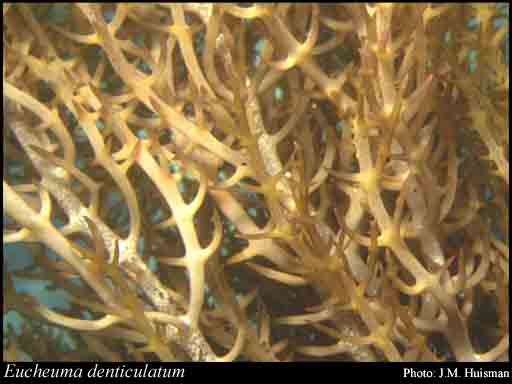- Reference
- Proc.Amer.Acad.Arts 53:106 (1917)
- Conservation Code
- Not threatened
- Naturalised Status
- Alien to Western Australia
- Name Status
- Current

Scientific Description
Habit and structure. Thallus erect, to 20 cm tall, or becoming secondarily prostrate and forming secondary attachments, dark red-brown to green. Axes terete, to 5 mm diam. basally (dried), tapering gradually to upper axes 2–3 mm diam., irregularly branched. Most axes with distinct lateral whorls of conical spinous branches every 2–10 mm, these to 1–2 mm long with broad bases, occasionally with numerous proliferous determinate laterals with obtuse apices, filling internodal spaces. Structure with a distinct filamentous core c. 500 µm diam., with filaments 12–20 µm diam., then a pseudoparenchymatous outer medulla of large hyaline cells to 100–150 µm diam., with numerous secondary pit connections to adjacent cells. Towards the cortex the medullary cells are slightly smaller, but with an abrupt transition to the cortex. Cortex of dichotomously divided filaments, often secondarily connected with adjacent filaments, 4–6 cells long, with elongate cells; outermost cells clavate to ellipsoidal, 5–8 µm long and 3–4 µm diam.
Reproduction. Reproductive structures not observed.
Distribution. Known in warmer waters of the Indo-Pacific.
Habitat. Epilithic in the intertidal and shallow subtidal.
[After J.M. Huisman in Algae of Australia: Marine Benthic Algae of North-western Australia, 2. Red Algae: 204 (2018)]
Distribution
- IBRA Regions
- Carnarvon, Dampierland, Pilbara.
- IBRA Subregions
- Cape Range, Pindanland, Roebourne.
- IMCRA Regions
- Abrolhos Islands, Bonaparte Gulf, Canning, Kimberley, Ningaloo, Pilbara (offshore).
- Local Government Areas (LGAs)
- Ashburton, Broome, Derby-West Kimberley, Exmouth, Greater Geraldton, Karratha, Wyndham-East Kimberley.